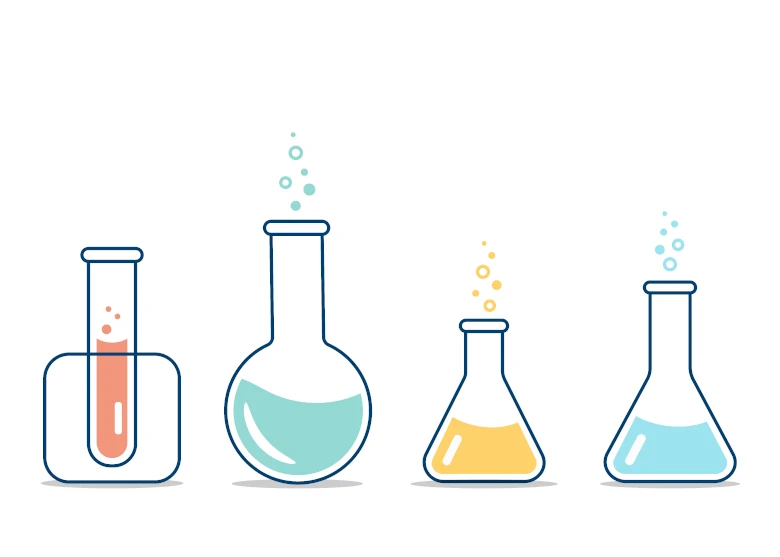Introduction to Qualitative Chemical Analysis

Chemistry is a fascinating subject that allows us to understand the composition, properties, and behaviour of matter. One essential aspect of chemistry, especially in O-level studies, is qualitative chemical analysis.
In this article, we will dive into the world of qualitative chemical analysis in chemistry, exploring its significance, basic principles, techniques, and real-life applications.
Qualitative Chemical Analysis: Definition
Qualitative Chemical analysis is the branch of chemistry concerned with identifying the components of a substance. It involves observing and analysing various properties and characteristics to determine the presence of specific ions or compounds.
Importance Of Qualitative Chemical Analysis In O-level Chemistry
Before delving into the details of qualitative hemical analysis, it's crucial to understand why it holds such importance in O Level Chemistry. Qualitative chemical analysis helps students develop a deeper comprehension of chemical reactions and equips them with practical skills for identifying substances based on their properties.
Basic Principles Of Qualitative Chemical Analysis
Qualitative Chemical analysis relies on a few fundamental principles. It involves identifying the presence or absence of certain ions or compounds in a given sample. The analysis is based on the unique properties of these substances, such as their colour, solubility, or reaction with specific reagents.
Common Techniques Used In Qualitative Chemical Analysis
-
Flame Test
Flame tests are employed to identify metal ions by observing the characteristic colours they emit when heated in a flame. This technique is particularly useful in identifying alkali and alkaline earth metals.
-
Precipitation Reaction
One of the most common techniques involves inducing chemical reactions in the sample to create visible precipitates. These precipitates are distinctive and can be used to identify specific ions or compounds.
-
Solubility Rules
Understanding the solubility of different compounds in various solvents is crucial for chemical analysis.
-
Acid-Base Reactions
Acid-base titrations are used to identify and quantify the concentration of acids or bases in a solution.
-
Chromatography
Chromatographic techniques are used to separate and analyse complex mixtures. High-performance liquid chromatography (HPLC) and gas chromatography (GC) are valuable tools in chemical analysis.
-
Complex Formation Reactions
Identifying metal ions through complex formation.
Step-By-Step Guide To Performing Qualitative Chemical Analysis
To perform qualitative analysis effectively, one must follow a systematic approach:
- Sample Preparation: Ensure the sample is in the right form for analysis.
- Addition of Reagents: Introduce specific reagents to trigger chemical reactions.
- Observation: Carefully observe any changes, such as colour or precipitate formation.
- Inference: Deduce the presence or absence of ions based on observations.
- Confirmation Tests: Conduct further tests to confirm results.
Common Reagents And Indicators
-
Silver Nitrate (AgNO3)
Silver nitrate is commonly used to test for the presence of halide ions. It forms insoluble silver halides with chloride, bromide, and iodide ions, each of which has a distinct colour.
-
Litmus Paper
Litmus paper is a simple indicator used to test for the acidity or alkalinity of a solution. It turns red under acidic conditions and blue under alkaline conditions.
-
pH indicators
A range of pH indicators, such as phenolphthalein and universal indicator, are employed to determine the pH of a solution. They change colour at specific pH values, aiding in chemical analysis.
Limitations And Challenges In Qualitative Chemical Analysis
While qualitative chemical analysis is a powerful tool, it has its limitations. Impurities, interference from other substances, and the sensitivity of tests can pose challenges.
-
Interference
Sometimes, the presence of one substance can interfere with the detection of another. Careful consideration and additional tests are required to overcome these challenges.
-
Sample Contamination
Contamination of the sample or equipment can lead to erroneous results. Stringent laboratory practices are essential to ensure accurate qualitative chemical analysis.
-
Safety Concerns
Qualitative chemical analysis often involves the use of chemicals that can be hazardous if not handled properly. Safety precautions and protective gear are essential to ensure the well-being of the analyst.
Real-Life Applications Of Qualitative Chemical Analysis
Qualitative chemical analysis isn't confined to the classroom; it has practical applications in various fields.
-
Uncovering The Unknown
Qualitative chemical analysis is like a detective's magnifying glass in the world of chemistry. It allows us to unravel the mysteries hidden within substances. When you encounter an unfamiliar sample, qualitative analysis steps in to identify its components, providing insights into its properties and potential uses.
-
Quality Control
Industries, especially pharmaceuticals and food processing, rely heavily on qualitative chemical analysis to ensure the quality and safety of their products. By identifying impurities or contaminants, companies can maintain the high standards necessary for consumer safety.
Environmental Monitoring
Environmental scientists use qualitative chemical analysis to assess the composition of soil, water, and air samples. By detecting pollutants and their sources, they can devise strategies to mitigate environmental issues and protect ecosystems.
Importance Of Accuracy And Precision
Precision is vital. Even small errors can lead to incorrect conclusions. Therefore, students must pay close attention to detail and follow standardised procedures.
In conclusion, qualitative chemical analysis in chemistry is an indispensable aspect of O-level studies. It enables students to apply theoretical knowledge in practical situations and has real-world applications in various industries. Mastering qualitative chemical analysis not only enhances one's understanding of chemistry but also fosters critical thinking and problem-solving skills.
 SG
SG  VN
VN 










